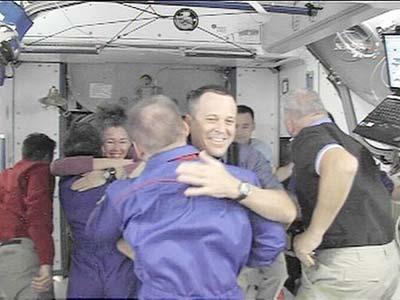Source: Xinhua
03-26-2009 11:38
Special Report: Tech MaxWASHINGTON, March 25 (Xinhua) -- The U.S. space shuttle Discovery undocked from the International Space Station on Wednesday, beginning its trip back to Earth, NASA TV reported.
 |
| In this image from NASA Television, Wednesday, March 25, 2009, shuttle Discovery astronauts hug with international space station astronauts as they depart the ISS. Space shuttle Discovery has left the international space station. The shuttle undocked from the orbiting outpost Wednesday after eight days. Discovery and its crew of seven are due back Saturday. (Xinhua/AFP Photo) |
Before undocking, astronauts embraced and said good-bye to each other, then sealed the hatches between Discovery and the space station.
"You made the space station much better than it was before," the space station's skipper, Mike Fincke, told the shuttle astronauts. "You gave us more power, symmetry -- which is not to be underrated -- and you gave us a new crew member."
The space station's new crew member is Koichi Wakata, the first Japan Aerospace Exploration Agency's resident station crew member. He replaced NASA astronaut Sandra Magnus as part of the station's Expedition 18 crew.
During Discovery's eight-day stay with the space station, astronauts conducted three spacewalks to install the S6 truss segment to the starboard, or right side of the station, and deploy its fourth and final set of solar array wings.
Altogether, the station's arrays can generate as much as 120 kilowatts of usable electricity -- enough to provide about 422,800-square-foot (260 square meters) homes with power. The arrays will provide the electricity to fully power science experiments and support the station's expanded crew of six in May.
